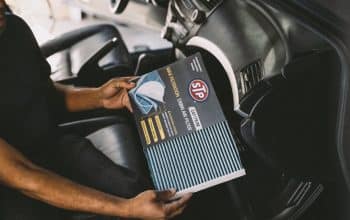Why Is My Car Drifting To The Right? It’s not uncommon for cars to drift to the right after an alignment, leaving drivers to question what the cause of the issue could be.
Wheel misalignment is generally caused by problems with the suspension system, impact damage, incorrect tire pressure, or other issues that affect the alignment of the wheels.
If you’ve been driving your car and noticed that it’s been dragging to the right, it can be extremely irritating and hazardous. This is a phenomenon known as drifting, which can be caused by a variety of mechanical issues.
Read on to find out why your car drifts to the right after alignment, and how to fix it.
Why Does Car Drift to the Right After Alignment?
Impact damage
If your car hits a curb, pothole, or other objects, it can cause the wheels to become misaligned. The impact can damage the suspension components or cause the tires to become out of balance, which can result in the car drifting or pulling to one side.
Worn or damaged suspension components:
The suspension system, which includes the shocks, struts, and other components, can wear out over time or become damaged, which can cause the wheels to become misaligned.
Incorrect tire pressure:
If the tire pressure is too low, it can cause the tire to bulge outward and the wheel to become misaligned. Similarly, if the tire pressure is too high, it can cause the tire to become overly stiff and the wheel to become misaligned.
It is important to maintain the correct tire pressure as specified by the manufacturer of your vehicle.
Incorrectly installed suspension components:
If the suspension components are not installed correctly, it can cause the wheels to become misaligned.
Overloading the vehicle:
If you consistently carry a heavy load in your car, or if you frequently tow a trailer, it can cause additional strain on the suspension system. This can lead to the wheels becoming misaligned.
It is important to not exceed the recommended weight capacity of your vehicle. The maximum weight capacity can be found in the owner’s manual or on the vehicle’s placard, which is usually located on the driver’s side door jamb or inside the fuel filler door. Exceeding the weight capacity can not only cause wheel misalignment, but can also lead to other problems such as reduced fuel efficiency, increased tire wear, and reduced vehicle stability.
Can Alignment Cause Wandering?
Wheel alignment can potentially cause a car to wander or drift, especially if the alignment is significantly off. When the wheels are not properly aligned, it can cause the car to pull to one side or the other, or it can cause the steering to feel loose or unresponsive.
However, it is important to note that there are many other potential causes of a car wandering or drifting, including problems with the suspension system, steering system, or tires.
How Do I Know If I Messed Up My Alignment?
A car’s alignment should be checked regularly, particularly after big changes in the road surface or after colliding with another car or object. But how do you know if you messed up your alignment?
The signs of poor alignment are usually quite clear, even to someone who is not a trained car mechanic. Below are the common signs that indicate there is something wrong with your alignment:
Vehicle Pulls:
If your car pulls to one side while you are driving on a straight, flat road, it’s a sign that your alignment is off. This could be caused by a misalignment of one or more of the tires in relation to the other tires. Here are some possible scenarios that are likely to happen and if you notice either of these problems in your car, it’s likely that the wheel of your car is out of alignment:
- Your car pulling to one side alignment
- You notice the car pulls to one side when braking or accelerating
- It pulls to one side even after it installing new tires
Uneven Tire Wear:
Uneven wear on your tires can be a sign of poor alignment. This is especially true if the wear pattern appears on the outer edges of the tread or on one side only.
Vibrations and shaking
If you experience the steering wheel may start shaking and the car pulling to one side it could be a sign that the wheels are misaligned. This vibration is usually caused when the wheels do not have a consistent speed or pattern. Even if the steering wheel vibrates when you’re driving straight, the cause could still be misaligned wheels.
Strange Noises:
Unusual noises such as clunking, grinding, or scraping may indicate that there is something wrong with the alignment of your wheels.
Steering Issues:
Difficulty steering your car could be an indication that your alignment is off. If you’re having trouble keeping your car in a straight line, or if the steering wheel doesn’t respond to your commands in the way that it used to, it’s a good indication that you should have the alignment checked.
How Much Does It Cost to Fix an Out-of-Alignment Wheel?
If your car is experiencing any of the above signs or if it’s been quite some time since you’ve had your alignment checked, it’s time to head to the mechanic and have it inspected.
The cost of a wheel alignment can vary depending on the make and model of your vehicle, the type of alignment you need, and the location where you have the work done.
On average, a wheel alignment can cost anywhere from $50 to $100 for a front-end alignment, and $100 to $200 for a four-wheel alignment.
Some shops may offer discounts for multiple alignments, or for having the work done along with other maintenance services.
What Happens When You Mess Up Your Alignment?
Your car’s alignment involves the angles of the tires’ contact with the road, ensuring the vehicle is going straight and steering correctly. When the alignment is out of sorts, steering a vehicle becomes difficult, and the vehicle won’t track straight, causing strain on disc brakes and tires.
Poor alignment can lead to all sorts of dangerous driving issues, from decreased control and handling to increased wear and tear on your vehicle and its components.
Mess up your alignment and you’re going to notice several issues as soon as you’re driving, such as pulling to one side, a “floating” feeling during turns, and increased tire wear. You may also experience vibrations in the car, as well as squealing tires and greater difficulty steering in a straight line.
Why Is My Steering Wheel Not Centered After Alignment?
One of the most common causes is incorrect wheel alignment settings. Depending on the severity of the alignment issue, the wheel alignment settings may have been set too low or too high, leading to an uncentered wheel. Additionally, low air pressure in the tires can also cause misalignment. If your tires are not inflated to the recommended PSI, the wheel alignment may be off and cause your wheel to be uncentered.
Conclusion
In conclusion, car drift to the right after alignment can be caused by a variety of reasons, ranging from incorrect wheel alignment, worn tires, worn suspension components, or unbalanced wheels.
However, with adequate diagnostics and repairs, these issues can generally be corrected fairly easily. Fixing these issues can result in more enjoyable and safer drives, and you’ll also want to keep a close eye on your car’s alignment and tires to prevent drift in the future.
But most importantly, Adjustments like an out-of-alignment wheel should be done by a professional mechanic. It’s best to avoid taking such a risk if you’re inexperienced. After all, an improperly adjusted alignment won’t just cause discomfort and danger on the roads, but it can also potentially shorten the life of your tires and other key vehicle components.

